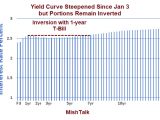
Alexandria Ocasio-Cortez’s Plan to Tax the Rich Is the Opposite of Radical
January 7, 2019Some politicians can move previously fringe ideas into the forefront of the debate without even trying. Alexandria Ocasio-Cortez's suggestion on 60 Minutes of a 70 percent top marginal tax rate for Americans earning over $10 million has people thinking again about what America could look like rather the oligarchy it currently is. But the real purpose of these ideas has been obscured amid a tired and one-sided argument about balanced budgets: As Ocasio-Cortez would likely tell you, there’s a big difference between trying to find revenues and trying to deliver progress to the country.
Jeff Stein at the Washington Post has done the math on this idea. Out of over 150,000,000 tax returns in 2016, the most recent year available, only 16,041 contained taxable income of over $10 million. That’s about 0.05 percent of all households who would be affected in any way by a 70 percent marginal tax bracket.
Furthermore, the rate would only apply to income over the first $10 million; that’s how tax brackets work. Earnings from investments like dividends and capital gains have their own tax rates, and wouldn’t be affected. Even “taxable income” refers only to income after deductions and credits. So wild statements about how Ocasio-Cortez means to “take away 70 percent of your income” are just lies intended to rile people up; rest assured, the rich would manage to survive (for better or worse).
When I ran the numbers, I found that a 70 percent tax bracket over $10 million in taxable income would have yielded $74.4 billion more in 2016. (The Post came up with $72 billion.) Over ten years, that equals approximately $744 billion in revenues, close to the $800 billion price tag placed on Bernie Sanders’s proposal for free college tuition at public colleges and universities, or the $800 billion needed to give newborns a “baby bond” endowment.
But we should be honest: there’s no way the change would bring in that much money. Which speaks to what little radicalism AOC is actually proposing here—despite the right-wing freak-out—while clarifying what it would take to make her broader vision a reality.
There’s a big difference between what the ultra-wealthy might declare as income with today’s highest marginal tax rate of 37 percent, versus under AOC’s dangled 70 percent rate. There’s an entire industry of tax sheltering and avoidance, conducted by knowledgeable and legally savvy (or shady) accountants, ensuring the rich pay as little as possible.
It’s just common sense that this industry would take on far more urgency if America had higher tax rates. For example, international tax havens would likely become more popular for parking income. More compensation could be issued as stock, which wouldn’t be affected by a new tax bracket. Creative accounting would conceal more money from the feds.
The Trump tax cuts created another legal tax avoidance scheme: a giant deduction for “pass-through” income. This is money derived from a business that is taxed at a personal level. It’s incredibly easy for a wealthy individual to establish a business and take advantage of the new pass-through rules, canceling 20 percent of their income with one deduction.
It’s hard to say exactly how much tax avoidance would eat away at any yields from a 70 percent tax bracket. But whatever the numbers, the intake would end up far lower than the estimated $2 trillion that might be needed just to build out renewable energy sources as part of a Green New Deal, or the roughly $32 trillion over a decade projected to fund Medicare for All.
If your only goal were to raise revenues, there are other options. Reversing the 2017 Trump tax cuts in just a few areas—the “pass-through” changes, the reduction in corporate taxes, the rollback of the inheritance tax and new deductions for foreign dividends —would bring back $3 trillion over ten years.
A 0.1 percent tax on stock and bond trades would raise $777 billion over a decade, more than a 70 percent bracket. Treating capital gains as ordinary income would add roughly $161 billion per year, with over two-thirds of the people benefitting from the current cushy structure being millionaires. And taxes on wealth rather than income, like those that exist in Norway and Spain, for example, would really get at where the money is. A small 1 percent wealth tax on all wealth above $10 million would net $2 trillion over ten years, according to the Post's aforementioned analysis.
Of course, the rich could defer capital gains, disguise stock trades, and hide wealth. In fact, it’s hard to imagine any new tax revenues being maximally effective without a more serious commitment to tax enforcement. The IRS estimated in 2016 that America lost $458 billion every year from tax evasion. Republicans have gutted funding for tax enforcement under the Trump presidency, likely sending this number higher. Investing in the IRS wouldn’t end tax evasion entirely, but would probably bring in significant funds.
Similarly, global tax havens cost $150 billion a year in tax avoidance, according to a 2013 report from the left-leaning Public Interest Research Group. America could fight to dismantle tax havens with the same aggressiveness it fights businesses doing transactions with what it deems “rogue states.” In other words, instead of using international finance rules as a tool of foreign policy, we could use it to stop corporations and the wealthy from hoarding cash.
But musing about how to raise money assumes that such revenue is required to “fund” government operations. We know that Ocasio-Cortez finds such assumptions dangerous. She subscribes to modern monetary theory, which argues that any country with its own currency isn’t constrained by federal debt. Just last week, Ocasio-Cortez voted against the House rules package because it contained a “paygo” requirement that all new spending must be offset by budget cuts or tax increases. In her conception, meeting public needs deserves a much higher priority than the budget deficit.
So why, then, would Ocasio-Cortez suggest higher tax rates on the rich? Maybe it’s because they could discourage runaway compensation at the top that has triggered skyrocketing income inequality. When the US had a 91 percent top marginal tax rate in the 1950s, hardly anyone actually paid it. But CEOs made far less than they do today; why would they ask for a heavy raise if the government was going to grab most of it anyway?
Economists have a name for this era: the Great Compression, when the spread between ordinary workers and the wealthiest narrowed significantly. Seen this way, the goal of high tax rates at the top may be just to make society a little more equal, to avoid all the negative consequences of government corruption and social unrest that accompany an unequal society. In fact, the economy mostly grew faster during the Great Compression.
So when you look at Ocasio-Cortez's suggestion on taxes, you shouldn’t think about it solely in terms of raising money. Think about it as perfecting our union.
Sign up for our newsletter to get the best of VICE delivered to your inbox daily.
Follow David Dayen on Twitter.


